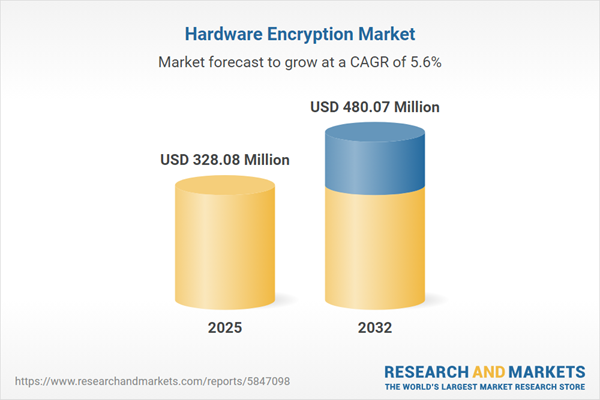Speak directly to the analyst to clarify any post sales queries you may have.
The hardware encryption market is evolving in response to complex digital threats and increased regulatory expectations. As organizations modernize IT infrastructure, hardware-based encryption emerges as a key solution to safeguard sensitive assets, enhance compliance, and mitigate diverse cyber risks.
Market Snapshot: Hardware Encryption Market Size and Growth Drivers
Driven by rising security requirements, the hardware encryption market expanded from USD 311.03 million in 2024 to USD 328.08 million in 2025, achieving a compound annual growth rate (CAGR) of 5.57%. Forecasts indicate market value will reach USD 480.07 million by 2032, reflecting increased adoption among sectors striving for regulatory compliance and stronger cyber defenses. Growth is underpinned by factors such as tighter regulations, escalating cyberattacks, and the integration of advanced encryption across financial services, government, healthcare, and critical infrastructure. The expanded adoption of cloud-native and edge security further positions hardware encryption as a foundation for building cyber-resilient enterprises.
Scope & Segmentation of the Hardware Encryption Market
- End User Industries: Banking, financial services, and insurance rely on robust, policy-driven encryption frameworks. Energy and utilities focus on securing systems with environment-resilient technology. Government and defense organizations depend on certified modules resistant to tampering. Healthcare protects personal health information from exposure. IT and telecom oversee high-volume and latency-sensitive data streams, while retail safeguards consumer and transaction data.
- Encryption Types: CPU-based encryption features such as AES-NI and Trusted Memory Encryption offer embedded security. Hardware Security Modules include network appliances, PCIe cards, and USB tokens that enforce institutional encryption controls. Self-encrypting drives, using NVMe, SAS, or SATA interfaces, protect data in storage devices. Software-supported mechanisms leverage API-based protocols for scalable and hybrid implementation.
- Deployment Models: Cloud-based hardware encryption solutions support rapid scalability across diverse environments. Hybrid deployment provides flexibility for organizations balancing compliance with operational needs. On-premises models enable granular control, suitable for highly regulated sectors requiring fully managed infrastructure.
- Applications: Key uses include protecting data at rest, safeguarding information in transit between devices or within networks, and delivering device-level controls to ensure comprehensive security coverage for digital infrastructure.
- Regions Covered: The Americas encompass the United States, Canada, Mexico, and emerging South American economies, each responding to distinct security frameworks. EMEA includes Europe’s established markets, Middle East technology drivers, and influential African jurisdictions. Asia-Pacific features high-growth countries such as China, India, Japan, and leading Southeast Asian nations, each shaped by local compliance trends and evolving digital risks.
- Leading Companies: Key providers include Thales S.A., UTIMACO GmbH, Futurex, IBM Corporation, Entrust Corporation, Cisco Systems, Atos SE, Infineon Technologies AG, NXP Semiconductors N.V., and STMicroelectronics N.V. These companies develop core encryption technologies and sector-specific solutions, supporting the requirements of regulated and high-risk markets.
Key Takeaways: Strategic Hardware Encryption Considerations
- Hardware-level encryption helps organizations meet increasingly strict security mandates and align with global compliance protocols across various operational environments.
- Advancements in trusted execution environments and integrated cryptographic processors, combined with machine learning-driven threat insights, are shaping more secure digital architectures.
- Industry-specific demands drive the need for tailored hardware encryption: low latency for financial transactions, environmental durability in energy operations, and certified modules in government applications.
- Diverse deployment options—including cloud, hybrid, and dedicated on-premises solutions—enhance organizational flexibility to address evolving regulations and support digital transformation.
- Ongoing innovation in post-quantum cryptography and hardware-based authentication builds resilience against emerging cyber threats and reinforces trust along the encryption supply chain.
Tariff Impact: Adaptations and Supplier Strategies
Forthcoming United States tariffs on select semiconductors and encryption hardware are encouraging enterprises to reevaluate sourcing models and procurement strategies. Organizations are diversifying supplier bases, cooperating with alternative foundries, and increasing investments in nearshore manufacturing to mitigate supply chain risks. Actions such as pursuing tariff exemptions and rationalizing regional sourcing are also playing a role in shaping long-term, resilient acquisition approaches.
Methodology & Data Sources
This analysis draws on interviews with senior security executives and integrates secondary research, including industry white papers, financial filings, patent analyses, and segment-specific insights. All figures and findings are independently validated to ensure reliability for strategic planning.
Why This Report Matters
- Senior leaders gain actionable insights into evolving global regulations, hardware encryption advances, and market positioning strategies tailored to the current risk landscape.
- Comprehensive segmentation and regional analysis support more effective planning for procurement, compliant deployment, and market expansion initiatives.
- Competitive benchmarking guides investments that reinforce digital resilience and drive secure business growth objectives.
Conclusion
Embedded hardware encryption empowers enterprises to address today’s security and compliance challenges. This report delivers the critical perspective necessary for sound investment and secure, long-term growth.
Additional Product Information:
- Purchase of this report includes 1 year online access with quarterly updates.
- This report can be updated on request. Please contact our Customer Experience team using the Ask a Question widget on our website.
Table of Contents
3. Executive Summary
4. Market Overview
7. Cumulative Impact of Artificial Intelligence 2025
List of Figures
Samples

LOADING...
Companies Mentioned
The key companies profiled in this Hardware Encryption market report include:- Thales S.A.
- UTIMACO GmbH
- Futurex, Inc.
- International Business Machines Corporation
- Entrust Corporation
- Cisco Systems, Inc.
- Atos SE
- Infineon Technologies AG
- NXP Semiconductors N.V.
- STMicroelectronics N.V.
Table Information
| Report Attribute | Details |
|---|---|
| No. of Pages | 187 |
| Published | October 2025 |
| Forecast Period | 2025 - 2032 |
| Estimated Market Value ( USD | $ 328.08 Million |
| Forecasted Market Value ( USD | $ 480.07 Million |
| Compound Annual Growth Rate | 5.5% |
| Regions Covered | Global |
| No. of Companies Mentioned | 11 |









